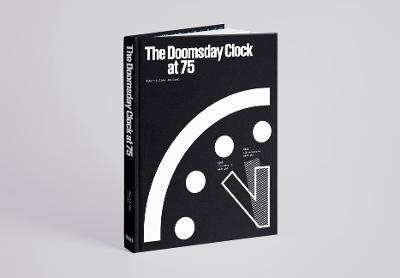The Doomsday Clock at 75

The Doomsday Clock at 75
The Doomsday Clock is many things all at once: It's a metaphor, it's a logo, it's a brand, and it's one of the most recognizable symbols of the past 100 years.
Chicago landscape artist Martyl Langsdorf, who went by her first name professionally, created the Doomsday Clock design for the June 1947 cover of the Bulletin of the Atomic Scientists, published by the news organization and nonprofit behind the iconic Doomsday Clock.
It sits at the crossroads of science and art, and therefore communicates an immediacy that few other forms can. As designer Michael Bierut says, the Clock is "the most powerful piece of information design of the 20th century."
The Doomsday Clock has permeated not only the media landscape but also culture itself. As you'll see in the pages of this book, more than a dozen musicians, including The Who, The Clash, and Smashing Pumpkins, have written songs about it.
It's referenced in countless novels (Stephen King, Piers Anthony), comic books (Watchmen, Stormwatch), movies (Dr. Strangelove, The Simpsons Movie, Justice League), and TV shows (Doctor Who, Madame Secretary). Even the shorthand, the way we announce time on the Doomsday Clock--"It Is Two Minutes to Midnight" (or whatever the current time might be)--has been adopted into the global vernacular.
Throughout the Doomsday Clock's 75 years, the Bulletin has worked to preserve its integrity and its scientific mission to educate and inform the public.
This is why, in part, we wanted to explore this powerful symbol and how it has impacted culture, politics, and global policy--and how it's helped shape discussions and strategies around nuclear risk, climate change, and disruptive technologies.
It's a symbol of danger, of hope, of caution, and of our responsibility to one another.
PRP: 259.20 Lei
Acesta este Prețul Recomandat de Producător. Prețul de vânzare al produsului este afișat mai jos.
233.28Lei
233.28Lei
259.20 LeiLivrare in 2-4 saptamani
Descrierea produsului
The Doomsday Clock is many things all at once: It's a metaphor, it's a logo, it's a brand, and it's one of the most recognizable symbols of the past 100 years.
Chicago landscape artist Martyl Langsdorf, who went by her first name professionally, created the Doomsday Clock design for the June 1947 cover of the Bulletin of the Atomic Scientists, published by the news organization and nonprofit behind the iconic Doomsday Clock.
It sits at the crossroads of science and art, and therefore communicates an immediacy that few other forms can. As designer Michael Bierut says, the Clock is "the most powerful piece of information design of the 20th century."
The Doomsday Clock has permeated not only the media landscape but also culture itself. As you'll see in the pages of this book, more than a dozen musicians, including The Who, The Clash, and Smashing Pumpkins, have written songs about it.
It's referenced in countless novels (Stephen King, Piers Anthony), comic books (Watchmen, Stormwatch), movies (Dr. Strangelove, The Simpsons Movie, Justice League), and TV shows (Doctor Who, Madame Secretary). Even the shorthand, the way we announce time on the Doomsday Clock--"It Is Two Minutes to Midnight" (or whatever the current time might be)--has been adopted into the global vernacular.
Throughout the Doomsday Clock's 75 years, the Bulletin has worked to preserve its integrity and its scientific mission to educate and inform the public.
This is why, in part, we wanted to explore this powerful symbol and how it has impacted culture, politics, and global policy--and how it's helped shape discussions and strategies around nuclear risk, climate change, and disruptive technologies.
It's a symbol of danger, of hope, of caution, and of our responsibility to one another.
Detaliile produsului










